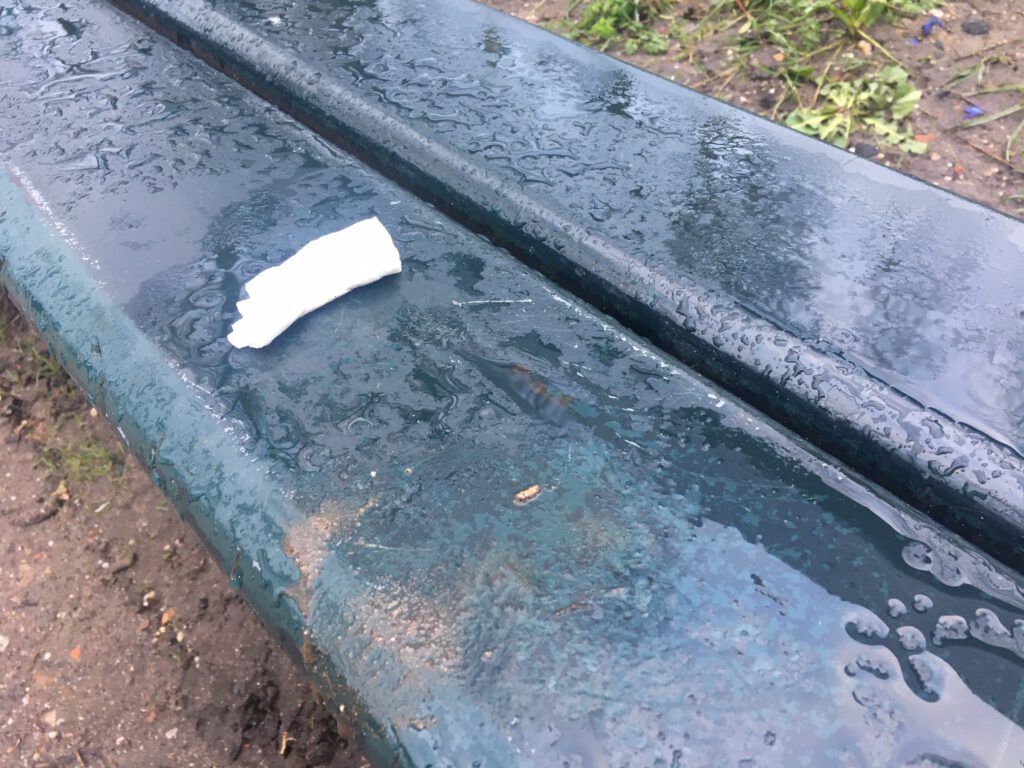Design process
Thanks for visiting this page! I would like to tell you more about how the DryBench was developed. First of all: I am a fan of design thinking*. From ‘it arises while you make it’ and from ‘learning by creating’. The DryBench™ has been developed according to the design thinking mindset and principles. On this page I gladly describe the innovation journey of this ‘folding sofa’….
It starts with walks through the Utrecht Zocherpark. I always go outside as soon as possible after a rain shower. But enjoying the sun from a bench is not one of them. The benches are (and will remain for a long time) soaking wet. Often there are also imprints of muddy feet of runners who tie their shoe laces. Or bird droppings.
This problem with street furniture requires a solution, I think the outdoor space could be better and smarter. I ‘frame’ the problem – as it is so beautifully called in design thinking. On intuition I choose a mindset for the solution and start experimenting within this ‘frame’.
I immediately skip the first logical frame: a dispenser with drying cloths next to each bench. Pointless. But such a ‘shindogu’ does get creativity going.
My first serious frame concerns the surface of the seat. All my solutions – including thin vertical slats, a water-repellent coating, a seat made of a water-permeable material (the inspiration is ZOAB) – appear not to sufficiently solve the problem or are not feasible.
Time for a different frame. My focus now is on keeping the seat out of the rain. I devise a seat that hinges. It doesn’t make it because you cannot expect a sofa seater to manually fold the seat for the next sofa seater. There are different types of foldable benches around which are connected to a wall and have to be folded by the owner by hand
The frame becomes even more specific: it does fold up, but then automatically, like a cinema seat. The next experiment concerns an automatically folding seat by means of a spring. That only works, it turns out that it is not maintenance-free in the open air. The solution is technically feasible but not sustainable and/or low maintenance.
Then the (last) frame: ‘Automatic folding using existing laws of nature’. And that’s where the folding bench comes from, which uses gravity through a counterweight. Prototyping of the counterweight position. This must be at the top of the carrier, so that the seat ‘folds through’ against the backrest.
And then the endless design, experimentation and reflection begins in collaboration with industrial designer Marc Platschorre and the technical talents of STEDON. Until there is a dry bench that is so logical that you wonder why it doesn’t exist yet and that we baptize DryBench.
From this moment on, the users will hook up. The people who will use the bank. And the people who are going to buy the bank. Based on the feedback from the municipality of Utrecht – ‘The DryBench foldingseat not only stays dry but also nice and narrow so that it fits well in narrow (shopping) streets’ – we decided to literally narrow our frame. The sofa and family members should take up as little space as possible. This means, among other things, a redesign of the counterweight (a piece of art by Jan Ate Zijlstra of STEDON) that now protrudes too far back and the addition of special brakes.

Thanks for reading, I hope it was inspiring.
Best regards,
Gerjon Zomer
* In my professional life I am an innovator, entrepreneur, investor and (Agile) coach. I provide workshops for organizations and teams that want to improve, accelerate or change. And I have written a series of light-hearted e-books that are about, among other things, Lean, Agile, Scrum, Kanban, Self-management, Design thinking and Storytelling. In other words: about all aspects of innovation in a rapidly changing world. You can find this Inspiration Series here (both Dutch and English).

